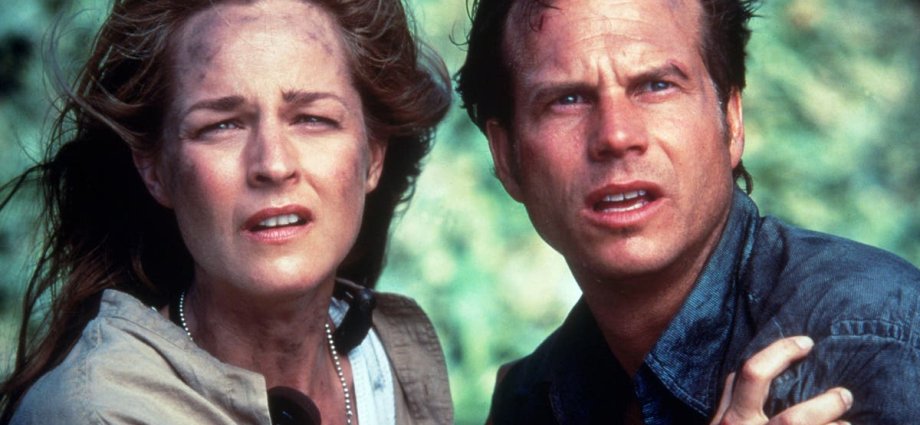The flying cow wasn’t that far-fetched. At the midpoint of Twister, the smash hit 1996 disaster movie that dazzled audiences with its gale-force effects, a poor bovine drifts across the sky like a lost balloon. And it once sort of happened. “We went into one little town just after a twister passed through,” the film’s stunt coordinator, Mic Rodgers, tells me. “It threw a 40-foot cattle truck 15 feet out into a field, and killed half the cows that were in it. I literally saw straw stuck into a telephone pole. Don’t ask me how that works.”
Part action film, part screwball romance between Bill Paxton and Helen Hunt, Twister was devised by writer Michael Crichton as an unholy mash-up of the classic romcom His Girl Friday and a PBS documentary about storm chasers that he’d seen on TV. Hunt plays Jo, a meteorologist whose father was sucked into a twister while she was a child. She’s dedicated her life to studying tornadoes, developing a device that’s designed to be sucked into vortexes of terrible weather to gather crucial data. Enter her estranged husband, Bill (Paxton), who has put his tornado-wrangling days behind him and is ready to settle down with a new, more sensible woman (Jami Gertz). But Jo, too preoccupied with saving rural midwestern communities, conveniently “forgot” to sign the divorce papers. Chasing storms alongside them are the late, great Philip Seymour Hoffman, Succession’s Alan Ruck and Todd Field, who’d go on to direct the Oscar-nominated Tár.
Twister was a surprise phenomenon upon release. On a budget of $90m (£69m), it raked in nearly $500m (£384m) at the global box office, second only in earnings that year to Independence Day but beating Mission: Impossible. A dedicated Twister museum was founded in Wakita, Kansas, and there was a spike in meteorology students in the late Nineties. When Paxton died in 2017, real-life storm chasers paid tribute in their droves. With a score featuring Van Halen, Twister was a distinctly Nineties disaster movie – think Volcano, Dante’s Peak and Armageddon – but, unlike its peers, the action still holds up in 2024. Many have recently revisited it in preparation for next week’s release of Twisters, a standalone sequel starring the currently ubiquitous Glen Powell and Normal People’s Daisy Edgar-Jones. Early reviews have been strong, while the lack of horror stories from the film’s production suggests at least some improvements have been made on its predecessor.
Filmed on location during tornado season in Oklahoma, the 1996 Twister was very much the product of director Jan de Bont, who had scored an enormous action hit two years earlier with Speed. Flexing his industry power – to often mutiny-inducing ends among the crew – De Bont insisted on getting away with as much as he could when it came to wind, rain and potential danger. “De Bont basically wanted as much realism as possible,” Rodgers recalls, adding that he and his motley crew of four stunt performers were sent off to get shots of the film’s key vehicles in front of real tornadoes before filming began. “We’d go on the road for like three or four days at a time chasing storms, trying to get in front of storms,” he says. “None of it was ever used in the movie.”
Rodgers says that cosplaying as a tornado hunter was often “bitchin’”, but that “one time was gnarly as hell”. He and his team had found a “wall cloud”, which is a tornado that touches the ground, and it was headed straight for them. They were warned to “get the f*** out of there”, but they insisted on staying. “All of a sudden, the wind picks up to like 70 miles an hour and it starts hailing,” Rodgers says. “Everyone’s bailing out, but the wind’s coming up against the passenger side of the truck and I can barely open the door. I throw myself in, my legs are still sticking out and I see [stunt double] Mike [Runyard] mash the gas pedal. He’s doing 90. We’re crabbing down the road. We’re sideways. We thought, ‘Oh, f***, we’re gonna die’. Then suddenly we popped out of it, and it’s like bright sky all around us.”
More chaos awaited when filming began, with De Bont making often outrageous demands. “He would shoot one direction, with all the equipment behind the view of the camera, and then he’d want to shoot in the other direction right away,” cinematographer Don Burgess told Entertainment Weekly magazine in 1996. “We’d have to move [everything] and he’d get angry that we took too long, and it was always everybody else’s fault, never his.” Burgess exited the film towards the end of production. De Bont, meanwhile, didn’t see any issue with his approach. “These crews get paid well, and when they screw up, I’m going to call them on it,” he told the magazine.
Rodgers is quick to insist that the Dutch filmmaker is “a great guy. Good director. Really good DP [director of photography]”. However, the De Bont at the lunch table was not the same person behind the lens. “As soon as he calls action, he turns into the 900-pound gorilla again,” he says. On one occasion, Rodgers recalls Hunt trying to get the director’s attention during a scene where she and Paxton were sitting in a truck being battered by a hailstorm. “She goes, ‘Jan! Jan! Do you want me to do the dialogue?’” In response, de Bont shouted: “Scream! Just scream, blonde girl, scream!” An incandescent Hunt started yelling obscenities at her director before Paxton rolled up the vehicle window.
De Bont’s most notorious outburst nearly scuppered the entire production. The crew was filming in a ditch one day, when the director shoved a camera assistant aside, who tripped and tumbled down the gulley. After the director refused to apologise for the incident, Burgess and his entire camera crew stormed off the set, promptly followed by the audio team, then the wardrobe department. “It had been brewing,” Rodgers remembers of the mass exodus. The next day, a private jet carrying Steven Spielberg arrived in Norman, Oklahoma. He was a producer on the film, and was largely responsible for getting it greenlit. De Bont was summoned to the airport.
“The ramp came down on the Learjet and Spielberg walked down it and he never touched the ground,” Rodgers says. “He just stood there yelling at Jan. He never even got off the plane. He was just f***ing yelling, pointing his finger at him, screaming at him. I don’t know what he said to him, but he barked at him for, like, 15 minutes and got back in the plane. The plane left without him even stepping off.”

Several injuries also occurred during filming. Hunt was struck in the head by a car door while she and Paxton were speeding through a cornfield. Sources told Entertainment Weekly at the time that she received a concussion. De Bont chalked it up to the actor being “a little bit clumsy”. Her stunt double fared even worse in the scene, cracking her rib as she bailed out of the vehicle. Hunt and Paxton were left temporarily blinded by powerful electric lamps and, with just two days of filming left, Burgess’s replacement Jack N Green was hospitalised when a hydraulic house set designed to collapse on cue was mistakenly activated with him inside it.
Reflecting on the eventful production in a 2020 interview with Vulture, Hunt admitted she “doesn’t know” if she could go through the filming process again, but that the movie “still holds up”. “I think that’s because [De Bont] didn’t rely on a lot of visual effects. He really threw s*** at us, and it looks amazing.” Her comments echo those of Paxton, who lobbied for a sequel for years before he died of a stroke aged 61. “Sure, there were hardships,” he admitted in 1995, interviewed before the film’s release. “You don’t put a story like this on the screen without paying the freight.” Maybe the film’s success can be surmised as… a perfect storm?
‘Twisters’ is in cinemas from 17 July











